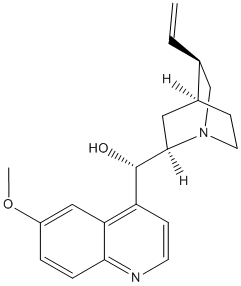
Quinidine is a pharmaceutical agent that acts as a class I antiarrhythmic agent in the heart. Quinidine is a stereoisomer of quinine, originally derived from the bark of the cinchona tree. Quinidine is used to treat abnormal heart rhythms. Like all other class I antiarrhythmic agents, quinidine primarily works by blocking the fast inward sodium current. At micromolar concentrations, quinidine inhibits Na+/K+-ATPase by binding to the same receptor sites as the digitalis glycosides such as ouabain. Quinidine is also used to treat malaria. The half life of oral quinidine is 6 to 8 hours, and it is eliminated by the cytochrome P450 system in the liver. About 20% is excreted unchanged via the kidneys. Quinidine is also an inhibitor of the cytochrome P450 enzyme 2D6, and can lead to increased blood levels of lidocaine, Beta blockers, opioids, and some anti-depressants. Quinidine also inhibits the transport protein P-glycoprotein and so can cause some peripherally acting drugs such as loperamide to have CNS side effects such as respiratory depression if the two drugs are co-administered.
| Molecular Weight | 324.42 |
| Formula | C20H24N2O2 |
| CAS Number | 56-54-2 |
| Solubility (25°C) | DMSO 50 mg/mL |
| Storage | 2-8°C, protect from light, sealed |
| Species | Mouse | Rat | Rabbit | Guinea pig | Hamster | Dog |
| Weight (kg) | 0.02 | 0.15 | 1.8 | 0.4 | 0.08 | 10 |
| Body Surface Area (m2) | 0.007 | 0.025 | 0.15 | 0.05 | 0.02 | 0.5 |
| Km factor | 3 | 6 | 12 | 8 | 5 | 20 |
| Animal A (mg/kg) = Animal B (mg/kg) multiplied by | Animal B Km |
| Animal A Km |
For example, to modify the dose of Compound A used for a mouse (20 mg/kg) to a dose based on the BSA for a rat, multiply 20 mg/kg by the Km factor for a mouse and then divide by the Km factor for a rat. This calculation results in a rat equivalent dose for Compound A of 10 mg/kg.
[1] Laura Vitali Serdoz, et al. Quinidine-A legacy within the modern era of antiarrhythmic therapy
[3] Felix Yang, et al. Quinidine revisited
| Related Anti-infection Products |
|---|
| Sulfogaiacol
Sulfogaiacol is a antitussive agent. Sulfogaiacol is used for acute respiratory tract infections, cough and other conditions. |
| 2,4-Dichlorobenzyl alcohol
2,4-Dichlorobenzyl alcohol is a mild antiseptic, with a broad spectrum for bacterial and virus associated with mouth and throat infections. |
| 1,2,3,4-Tetrahydronorharman-1-one
1,2,3,4-Tetrahydronorharman-1-one is a manzamine alkaloid with activity against infectious and tropical parasitic diseases from an Indonesian sponge. |
| Acetylalkannin
Acetylalkannin (Alkannin acetate) is an isohexenylnaphthazarin pigment isolated from Arnebia euchroma with antimicrobial and cytotoxic activities. |
| Chimeric Rabies Virus Glycoprotein Fragment (RVG-9R)
Chimeric Rabies Virus Glycoprotein Fragment (RVG-9R), a chimeric peptide consisting of 29 amino acids, is synthesized by adding nona-arginine motif to the carboxy terminus of RVG (rabies virus glycoprotein). |


Products are for research use only. Not for human use. We do not sell to patients.
© Copyright 2010-2023 AbMole BioScience. All Rights Reserved.
